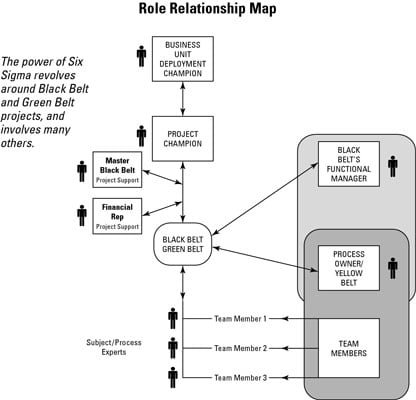The full deployment and implementation of a Six Sigma initiative in an organization requires the collective participation of numerous people, each of whom is responsible for fulfilling specific roles and obligations at both the managerial and technical levels. Most often, these people are drawn from within the ranks of the company and are specially trained to the requisite skills.
The core team
The core team is a unified body whose members perform an organizational assessment, benchmark products and services, conduct detailed gap analyses, create the operational vision, and develop implementation plans. The core team performs the following actions:
Making the initiative highly visible through active and personalized leadership, commitment, and passion for change
Installing the measurement system that tracks the progress, installs accountability into the initiative, and provides a visible dashboard of progress and efforts
Benchmarking products, services, and processes so that the organization can truly understand its relative position in the marketplace
Setting stretch goals that focus on changing the process by which work gets done rather than tweaking existing processes, leading to leapfrog rates of improvement
Providing knowledge and education to all levels of people because certain methods and tools are necessary to initiate and sustain breakthrough improvement
Evangelizing success stories that demonstrate how Six Sigma methods, technologies, and tools have been applied to achieve dramatic operational and financial improvements in other organizations
Developing and implementing a supporting infrastructure that enables Six Sigma to naturally occur and flourish in a company
Core team members include the following people and departments:
Key executive representatives
Functional representatives, including
Finance
Training
Information technology (IT)
Human resources
Communications
Six Sigma deployment leader
Business unit leaders
Functional representatives
Functional representatives are senior corporate staff members who run their respective departments or have large responsibility in those departments. They’re well respected leaders who can drive short-cycle change initiatives. Functional representatives include the following:
Finance representative:
Is the single point of contact for Six Sigma finance issues and coordinates all project auditing and validation activities
Determines how project costs and savings are defined, valued, and reported
Develops a project savings audit process and leads finance participation in the project selection and review processes
Defines accounting and budgeting requirements for Six Sigma-related expenses
Training representative:
Is the single point of contact for Six Sigma training issues and coordinates Six Sigma training activities for the entire corporation
Configures all training curricula and courseware for the Six Sigma initiative, including executive, Champion, Master Black Belt, Black Belt, Green Belt, Yellow Belt, DFSS, awareness training, and thinking for breakthrough
Schedules and coordinates all Six Sigma training courses, logistics, materials, and supplies and also develops training sign-up, tracking, and reporting processes
Information technology representative:
Is the single point of contact for Six Sigma IT issues and coordinates Six Sigma IT activities in all organizations
Arranges for purchase and distribution of Six Sigma software — along with the hardware necessary to support it — for training and knowledge transfer, analytical work, project management, and process improvement
Prepares and executes plans for providing end-user support for Six Sigma software
Human resources representative:
Is the single point of contact for Six Sigma human resources and coordinates all Six Sigma-related HR activities
Writes job descriptions for all Six Sigma positions and prepares an organizational chart that identifies the roles
Develops compensation packages for all Six Sigma positions and works with business leadership to configure reward, recognition, and career-development plans
Communications representative:
Is the single point of contact for all Six Sigma communication activities and leads the development and implementation of communication plans
Organizes a process for communicating internal successes and coordinates communication with stock analysts, suppliers, customers, partners, and investors
Arranges for the distribution of reference, informational, educational, and background material throughout the company
The deployment leader
The Six Sigma deployment leader is the single most important individual in the deployment process. The deployment leader is often a senior manager or executive who reports directly to the corporate-level person responsible for launching and sustaining Six Sigma.

Specific responsibilities of the deployment leader also include the following:
Ensuring accountability for the results of Six Sigma
Driving the vision and mission for Six Sigma into the organization
Removing barriers to successful implementations
Internally publicizing Six Sigma goals, plans, progress, results, and best practices
Creating and maintaining passion and commitment to Six Sigma goals
Updating executive leadership on the progress of the business units
Large corporations made up of many business units may need deployment leaders at the business unit level. Reporting directly to a business unit executive leader, the business unit deployment leader is responsible for initializing and implementing Six Sigma within her particular organization.
Meet the Six Sigma Champion
Six Sigma Champions are responsible for disseminating and successfully applying Six Sigma technical know-how. They develop a plan for transforming their organizations to “Six Sigma as the way we think and work.” Champions have long-standing rapport with key managerial and staff people and a demonstrated ability to pull people and resources together to achieve key objectives. The Six Sigma Champion
Identifies, selects, scopes, prioritizes, and assigns projects and aligns projects to business strategies
Selects Black Belts, Green Belts, and Yellow Belts and ensures that they’re appropriately trained, tasked, and deployed
Supports Black, Green, and Yellow Belts through the removal of organizational barriers, securing necessary resources, coaching, and reviewing project implementation status
Establishes an adequate backlog of projects and ensures that all Belts and Master Black Belts are fully dedicated to Six Sigma activities
Reports progress against target metrics to Champions
Promotes best-practices sharing and leverages solutions and improvements across organizational boundaries

